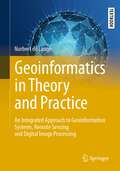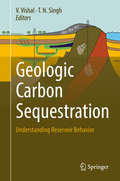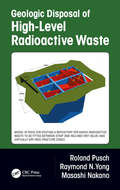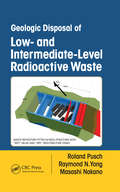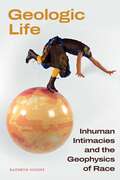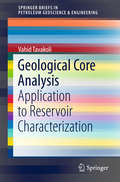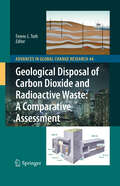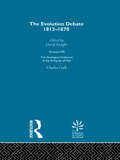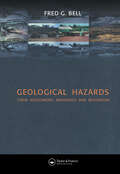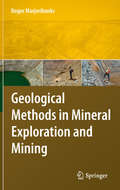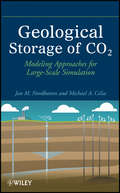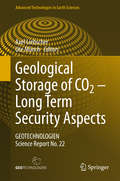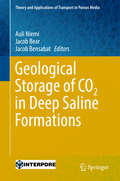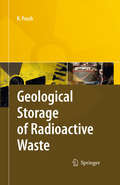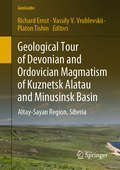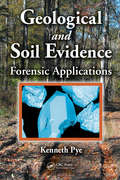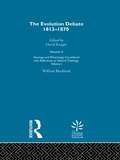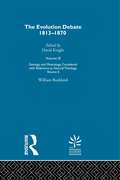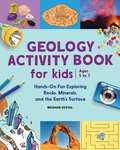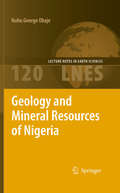- Table View
- List View
Geoinformatics in Theory and Practice: An Integrated Approach to Geoinformation Systems, Remote Sensing and Digital Image Processing (Springer Textbooks in Earth Sciences, Geography and Environment)
by Norbert de LangeThis textbook is intended to display a broad, methodological introduction to geoinformatics and geoinformation science. It deals with the recording, modeling, processing and analysis as well as presenting and distributing of geodata. As an integrated approach it is dedicated to the multidisciplinary application of methods and concepts of computer science to solve spatial tasks. First the reader receives an introduction to the approach and tasks of geoinformatics, basic concepts and general principles of information processing as well as essentials of computer science. Then this textbook focuses on the following topics: spatial reference systems, digital spatial data, interoperability of spatial data, visualization of spatial information, data organization and database systems, geoinformation systems, remote sensing and digital image processing.The result is a comprehensive manual for studies and practical applications in geoinformatics. It serves also as a basis to support and deepen methodological courses in geography, geology, geodesy and surveying as well as all environmental sciences. In this first English edition, the author has updated and significantly expanded the fourth German edition. New additions include the development of apps, graphical presentation on the web, geodata-bases and recent methods of classification. This book is based on the original German 4th edition Geoinformatik in Theorie und Praxis by Norbert de Lange, published by Springer-Verlag GmbH Germany, part of Springer Nature in 2020 and still presents the only integrated perspective on geoinformatics and geoinformation science. This book was translated with the help of artificial intelligence (machine translation by the service DeepL.com) first and then significantly revised with regard to technical terms and special topics of geoinformatics.
Geologic Carbon Sequestration
by V. Vishal T. N. SinghThis exclusive compilation written by eminent experts from more than ten countries, outlines the processes and methods for geologic sequestration in different sinks. It discusses and highlights the details of individual storage types, including recent advances in the science and technology of carbon storage. The topic is of immense interest to geoscientists, reservoir engineers, environmentalists and researchers from the scientific and industrial communities working on the methodologies for carbon dioxide storage. Increasing concentrations of anthropogenic carbon dioxide in the atmosphere are often held responsible for the rising temperature of the globe. Geologic sequestration prevents atmospheric release of the waste greenhouse gases by storing them underground for geologically significant periods of time. The book addresses the need for an understanding of carbon reservoir characteristics and behavior. Other book volumes on carbon capture, utilization and storage (CCUS) attempt to cover the entire process of CCUS, but the topic of geologic sequestration is not discussed in detail. This book focuses on the recent trends and up-to-date information on different storage rock types, ranging from deep saline aquifers to coal to basaltic formations.
Geologic Disasters and the Environment Laboratory Manual
by Robert Leighty Donna Benson Chloe Branciforte Kelli WakefieldMesa College Geology 111 Lab Manual
Geologic Disposal of High-Level Radioactive Waste
by Roland Pusch Raymond N Yong Masashi NakanoGeologic Disposal of High-Level Radioactive Waste examines the fundamental knowledge and conditions to be considered and applied by planners and other professionals when establishing national repository concepts, and constructing repositories for the long-term isolation of highly radioactive waste from surrounding crystalline rock. It emphasizes the important roles of structural geology, hydrogeology, hydrochemistry, and construction techniques. It specifically examines the disposal of steel canisters with spent reactor fuel in mined repositories (MR) at medium-depth, and in very deep boreholes (VDH). While disposal in mined repositories has been widely tested, the option of placing high-level radioactive waste in deep boreholes has been considered in the US, UK, and elsewhere in Europe, but has not yet been tested on a broad scale. This book examines the possibility of safe disposal for very long periods, proposing that the high salt content and density of groundwater at large depths are such that potentially contaminated water would not rise high enough to affect the more shallow biosphere. Features: Presents the best practices for disposal of spent fuel from nuclear reactors. Assesses waste isolation capacities in short- and long-term perspectives, and the associated risks. Describes site selection principles and the economics of construction of different types of repositories. Includes an appendix which provides the latest international recommendations and guidelines concerning the disposal of highly radioactive waste.
Geologic Disposal of Low- and Intermediate-Level Radioactive Waste
by Roland Pusch Masashi Nakano Raymond N. YongThis book will address concepts and techniques for preparation and disposal of low- (LLW) and intermediate-level (ILW) radioactive waste from the nuclear industry, the weapons industry, university labs, research institutes, and from the commercial industry. It will aid decision-makers in finding optimal technical/economical solutions, including how site investigations, design, construction, identification and selection of construction materials (clay and concrete), and monitoring can be made. It will also examine techniques for isolating soil and rock contaminated by leaking nuclear plants and from damaged nuclear reactors such as those at the Fukushima and Chernobyl nuclear plants.
Geologic Life: Inhuman Intimacies and the Geophysics of Race
by Kathryn YusoffIn Geologic Life, Kathryn Yusoff theorizes the processes by which race and racialization emerged geologically. Examining both the history of geology as a discipline and ongoing mineral and resource extraction, Yusoff locates forms of imperial geology embedded in Western and Enlightenment thought and highlights how it creates anti-Black, anti-Indigenous, and anti-Brown environmental and racial injustices. Throughout, she outlines how the disciplines of geology and geography---and their conventions: surveying, identifying, classifying, valuing, and extracting—established and perpetuated colonial practices that ordered the world and people along a racial axis. Examining the conceptualization of the inhuman as political, geophysical, and paleontological, Yusoff unearths an apartheid of materiality as distinct geospatial forms. This colonial practice of geology organized and underpinned racialized accounts of space and time in ways that materially made Anthropocene Earth. At the same time, Yusoff turns to Caribbean, Indigenous, and Black thought to chart a parallel geologic epistemology of the "earth-bound" that challenges what and who the humanities have chosen to overlook in its stories of the earth. By reconsidering the material epistemologies of the earth as an on-going geotrauma in colonial afterlives, Yusoff demonstrates that race is as much a geological formation as a biological one.
Geologic Trips: San Francisco and the Bay Area
by Ted KonigsmarkThis book is written for the non-geologist and describes seven geologic trips that will give the reader an understanding of the rocks, faults, earthquakes, and landforms of San Francisco and the Bay Area.
Geological Aspects of Hazardous Waste Management
by Stephen M. TestaGeologic Aspects of Hazardous Waste Management brings together technical, legislative, regulatory, and business aspects of hazardous waste issues as they pertain to preventing, assessing, containing, and remediating soil and groundwater contamination. The book emphasizes how subsurface geologic and hydrogeologic conditions affect the decision-making process, and it focuses on critical issues facing industry, government, and the public. The book is excellent for consultants, project managers, regulators, geologists, geophysicists, hydrologists, hydrogeologists, risk assessors, environmental engineers, chemists, toxicologists, and environmental lawyers.
Geological Core Analysis: Application To Reservoir Characterization (Springerbriefs In Petroleum Geoscience And Engineering Ser.)
by Vahid TavakoliThis book offers a compact guide to geological core analysis, covering both theoretical and practical aspects of geological studies of reservoir cores. It equips the reader with the knowledge needed to precisely and accurately analyse cores. The book begins by providing a description of a coring plan, coring, and core sampling and continues with a sample preparation for geological analysis. It then goes on to explain how the samples are named, classified and integrated in order to understand the geological properties that dictate reservoir characteristics. Subsequently, porosity and permeability data derived from routine experiments are combined to define geological rock types and reduce reservoir heterogeneity. Sequence stratigraphy is introduced for reservoir zonation. Core log preparation is also covered, allowing reservoirs to be analysed even more accurately. As the study of core samples is the only way to accurately gauge reservoir properties, this book provides a useful guide for all geologists and engineers working with subsurface samples.
Geological Disposal of Carbon Dioxide and Radioactive Waste: A Comparative Assessment
by Ferenc L. TothFossil fuels will remain the backbone of the global energy economy for the foreseeable future. The contribution of nuclear energy to the global energy supply is also expected to increase. With the pressing need to mitigate climate change and reduce greenhouse gas emissions, the fossil energy industry is exploring the possibility of carbon dioxide disposal in geological media. Geological disposal has been studied for decades by the nuclear industry with a view to ensuring the safe containment of its wastes. Geological disposal of carbon dioxide and that of radioactive waste gives rise to many common concerns in domains ranging from geology to public acceptance. In this respect, comparative assessments reveal many similarities, ranging from the transformation of the geological environment and safety and monitoring concerns to regulatory, liability and public acceptance issues. However, there are profound differences on a broad range of issues as well, such as the quantities and hazardous features of the materials to be disposed of, the characteristics of the targeted geological media, the site engineering technologies involved and the timescales required for safe containment at the disposal location. There are ample opportunities to learn from comparisons and to derive insights that will assist policymakers responsible for national energy strategies and international climate policies.
Geological Evidence of the Antiquity of Man, 1863: With Remarks On Theories Of The Origin Of Species By Variation
by Charles LyellCharles Lyell's argument in this classic volume is that the processes of nature are slow and uniform, and that the Earth is in consequence hundreds of millions of years old. This work includes his prediction that if our nearest relatives are great apes, then the places to look for human fossils will be central Africa and Indonesia.
Geological Hazards: Their Assessment, Avoidance and Mitigation
by Fred G. BellNatural hazards cost the global economy over $50,000 million per year. Two thirds of this is spent on damage repair, the remainder represents the cost of predicting, preventing and mitigating against disasters. Man-made hazards such as groundwater pollution, subsidence and soil erosion add to this figure. Geological Hazards presents a state-of-the-art survey and examines methods of assessing, evaluating and combating hazards, both natural and man-made.
Geological Methods in Mineral Exploration and Mining
by Roger MarjoribanksThis practical step-by-step guide describes the key geological field techniques needed by today's exploration geologists involved in the search for metallic deposits. The techniques described are fundamental to the collection, storage and presentation of geological data and their use to locate ore. This book explains the various tasks which the exploration geologist is asked to perform in the sequence in which they might be employed in an actual exploration project. Hints and tips are give. The steps are illustrated with numerous examples drawn from real projects on which the author has worked. The book emphasizes traditional skills and shows how they can be combined effectively with modern technological approaches.
Geological Storage of CO2
by Jan Martin Nordbotten Michael A. CeliaDespite the large research effort in both public and commercial companies, no textbook has yet been written on this subject. This book aims to provide an overview to the topic of Carbon Capture and Storage (CSS), while at the same time focusing on the dominant processes and the mathematical and numerical methods that need to be employed in order to analyze the relevant systems. The book clearly states the carbon problem and the role of CCS and carbon storage. Thereafter, it provides an introduction to single phase and multi-phase flow in porous media, including some of the most common mathematical analysis and an overview of numerical methods for the equations. A considerable part of the book discusses the appropriate scales of modeling, and how to formulate consistent governing equations at these scales. The book also illustrates real world data sets and how the ideas in the book can be exploited through combinations of analytical and numerical approaches.
Geological Storage of CO2 - Long Term Security Aspects
by Ute Münch Axel LiebscherThis book explores the industrial use of secure, permanent storage technologies for carbon dioxide (CO2), especially geological CO2 storage. Readers are invited to discover how this greenhouse gas could be spared from permanent release into the atmosphere through storage in deep rock formations. Themes explored here include CO2 reservoir management, caprock formation, bio-chemical processes and fluid migration. Particular attention is given to groundwater protection, the improvement of sensor technology, borehole seals and cement quality. A collaborative work by scientists and industrial partners, this volume presents original research, it investigates several aspects of innovative technologies for medium-term use and it includes a detailed risk analysis. Coal-based power generation, energy consuming industrial processes (such as steel and cement) and the burning of biomass all result in carbon dioxide. Those involved in such industries who are considering geological storage of CO2, as well as earth scientists and engineers will value this book and the innovative monitoring methods described. Researchers in the field of computer imaging and pattern recognition will also find something of interest in these chapters.
Geological Storage of CO2 in Deep Saline Formations
by Jacob Bear Auli Niemi Jacob BensabatThis book offers readers a comprehensive overview, and an in-depth understanding, of suitable methods for quantifying and characterizing saline aquifers for the geological storage of CO2. It begins with a general overview of the methodology and the processes that take place when CO2 is injected and stored in deep saline-water-containing formations. It subsequently presents mathematical and numerical models used for predicting the consequences of CO2 injection. This book provides descriptions of relevant experimental methods, from laboratory experiments to field scale site characterization and techniques for monitoring spreading of the injected CO2 within the formation. Experiences from a number of important field injection projects are reviewed, as are those from CO2 natural analog sites. Lastly, the book presents relevant risk management methods. Geological storage of CO2 is widely considered to be a key technology capable of substantially reducing the amount of CO2 released into the atmosphere, thereby reducing the negative impacts of such releases on the global climate. Around the world, projects are already in full swing, while others are now being initiated and executed to demonstrate the technology. Deep saline formations are the geological formations considered to hold the highest storage potential, due to their abundance worldwide. To date, however, these formations have been relatively poorly characterized, due to their low economic value. Accordingly, the processes involved in injecting and storing CO2 in such formations still need to be better quantified and methods for characterizing, modeling and monitoring this type of CO2 storage in such formations must be rapidly developed and refined.
Geological Storage of Highly Radioactive Waste
by Roland PuschThe book describes and assesses current concepts for long-term disposal of highly radioactive waste. Different types of rock are discussed and assessed with respect to practical difficulties in the construction of a repository, and the efficiency of isolating radioactive waste. Safety matters are most important and are treated in the respective chapters and in a final, conclusive chapter. Cost issues and related quality matters are discussed for the case of constructing a virgin repository and repositories in the form of converted abandoned mines.
Geological Tour of Devonian and Ordovician Magmatism of Kuznetsk Alatau and Minusinsk Basin: Altay-Sayan Region, Siberia (GeoGuide)
by Richard Ernst Vassily V. Vrublevskii Platon TishinThis volume provides an overview and tour (with many interesting stops along the way) of Devonian and Ordovician intraplate magmatism and associated sedimentary rocks and tectonics in the regions of Kuznetsk Alatau, Minusinsk Basin and Khakassia in western Siberia. All chapters were written by experts, many of which have been studying these regions for decades. The first book to present and review this information in English for an international audience, it includes both overviews of the magmatic and associated sedimentary history, and selected key field sites, which are described in detail.
Geological and Soil Evidence: Forensic Applications
by Kenneth PyeThe forensic potential of geological and soil evidence has been recognized for more than a century, but recently these types of evidence are used much more widely as an investigative intelligence tool and as evidence in court. There is, however, still a poor understanding of the potential value and the limitations of geological and soil evidence am
Geology & Mineralogy, Considered with Reference to Natural Theology, Volume I, 1836 (The\evolution Debate, 1813-1870 Ser.)
by William BucklandMoving away from his earlier belief in a short, catastrophic history of the Earth, this volume shows how Buckland envisages instead progressive change as the Earth gradually cooled as it was prepared for human occupation. Extinct creatures did not die out because they were poorly designed; God loved the dinosaurs and had adapted them to their various circumstances.
Geology & Mineralogy, Considered with Reference to Natural Theology, Volume II, 1836
by William BucklandMoving away from his earlier belief in a short, catastrophic history of the Earth, this volume shows how Buckland envisages instead progressive change as the Earth gradually cooled as it was prepared for human occupation. Extinct creatures did not die out because they were poorly designed; God loved the dinosaurs and had adapted them to their various circumstances.
Geology (Sassafras Science Adventures #5)
by Johnny Congo Paige HudsonTake an adventure to learn about rocks and more with Sassafras Science! In The Sassafras Science Adventures Volume Five: Geology, the zip-lining science adventure rolls on for Blaine and Tracey Sassafras! The twins and your students will learn about rocks, fossils, maps, and more as they zip around the globe visiting the Norwegian countryside, the ice of Antarctica, and a deep, dark cavern in Australia! Don’t miss a minute of their summer-long zip line journey with their crazy Uncle Cecil!
Geology 103: Physical Geology Laboratory Manual
by Robert Leighty Donna BensonIn this Introduction to Physical Geology lab, you will acquire skills that you can use to make discoveries about your natural surroundings. Every week you will learn and apply basic concepts in exercises related to real places in Arizona and around the world. Many of the activities in this class are designed to compliment each other to help reinforce your learning. The goal will be accomplished if you come away from this class with more confidence in your knowledge of geology and with a greater appreciation of the natural world around you.
Geology Activity Book For Kids: Hands-On Fun Exploring Rocks, Minerals, and the Earth's Surface
by Meghan VestalHelp kids discover how mountains are formed and rocks are made with this interactive geology book for ages 5-7Learning about rocks and minerals is a lot more fun when kids can get their hands dirty. This book on rocks teaches budding scientists all about planet Earth through 19 geological topics that feature hands-on experiments, on-page activities, and fascinating facts.What sets this geology book apart from other rock books for kids:Real-life experiments—Kids can see what it's like to be a geologist with simple yet fascinating experiments such as pulling core samples from a candy bar, growing crystals, and creating a volcanic eruption!Earth-based activities—A variety of games, puzzles, and facts help young readers better understand geological concepts and build their scientific vocabulary.Rock spotting—This is also a rock identification book where kids can learn how to identify the rocks and minerals being used in the world around them, from the kitchen to the classroom.Inspire geology kids with this interactive exploring nature activity book—it's a standout among geology books for kids.
Geology and Mineral Resources of Nigeria
by Nuhu George ObajeContains details on the geological units of Nigeria and the associated mineral resources. The book is divided into three parts. Part 1 discusses the geology of the crystalline rocks and their regional distribution while the sedimentary basins constitute the subject of Part 2. Part 3 takes the mineral resources of Nigeria one on one, their geological environment, mode of occurrence, localities and where possible the reserves estimation. Thereafter, an account of the previous and current mining policies (including that of petroleum) of the Nigerian government is given and goes ahead to list some specific investment opportunities in the solid minerals sector.
